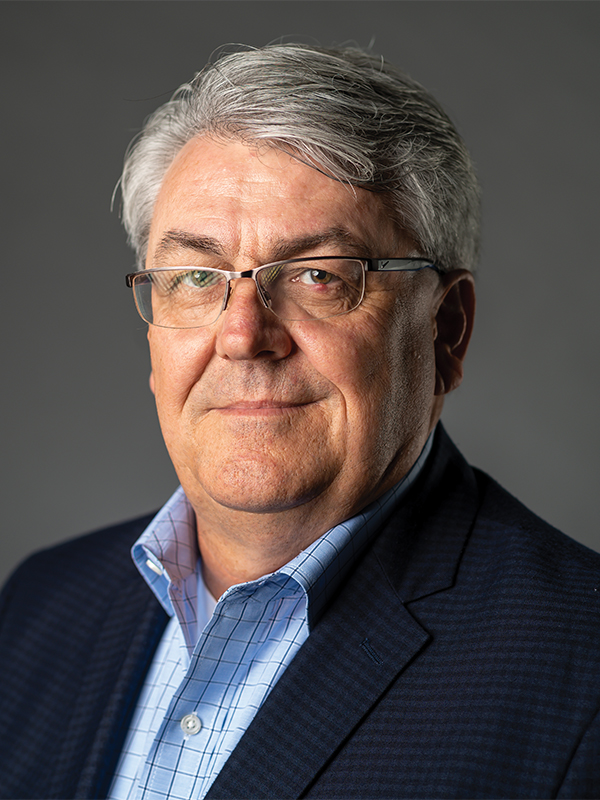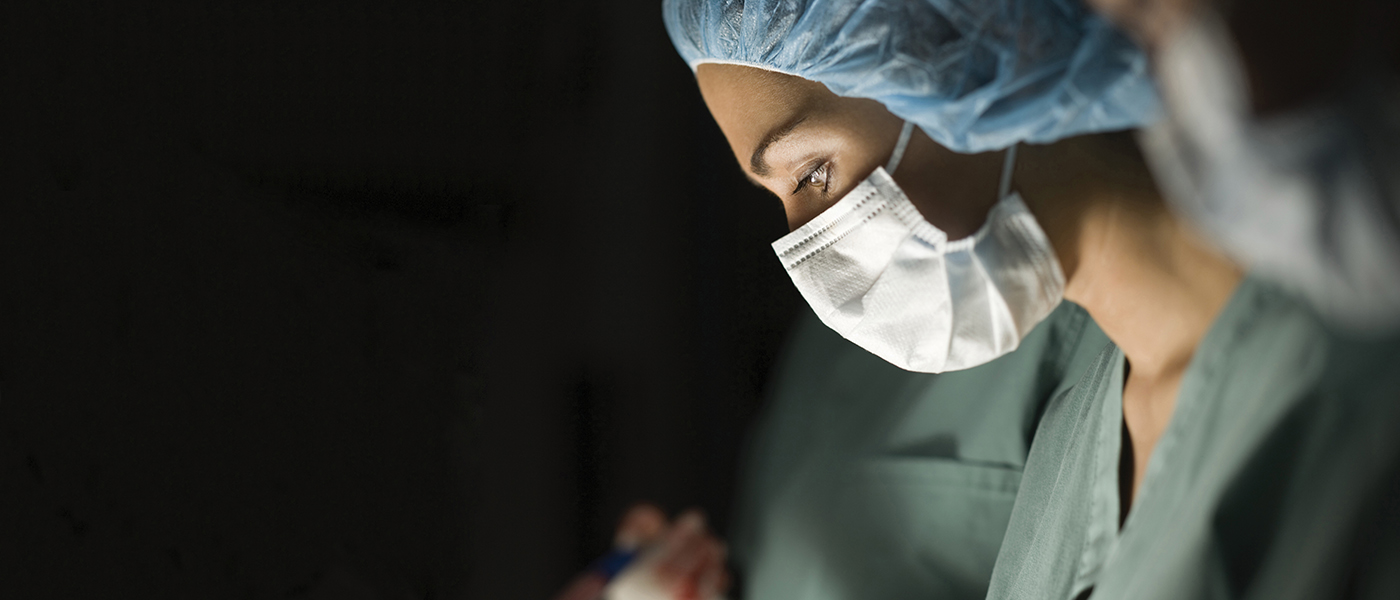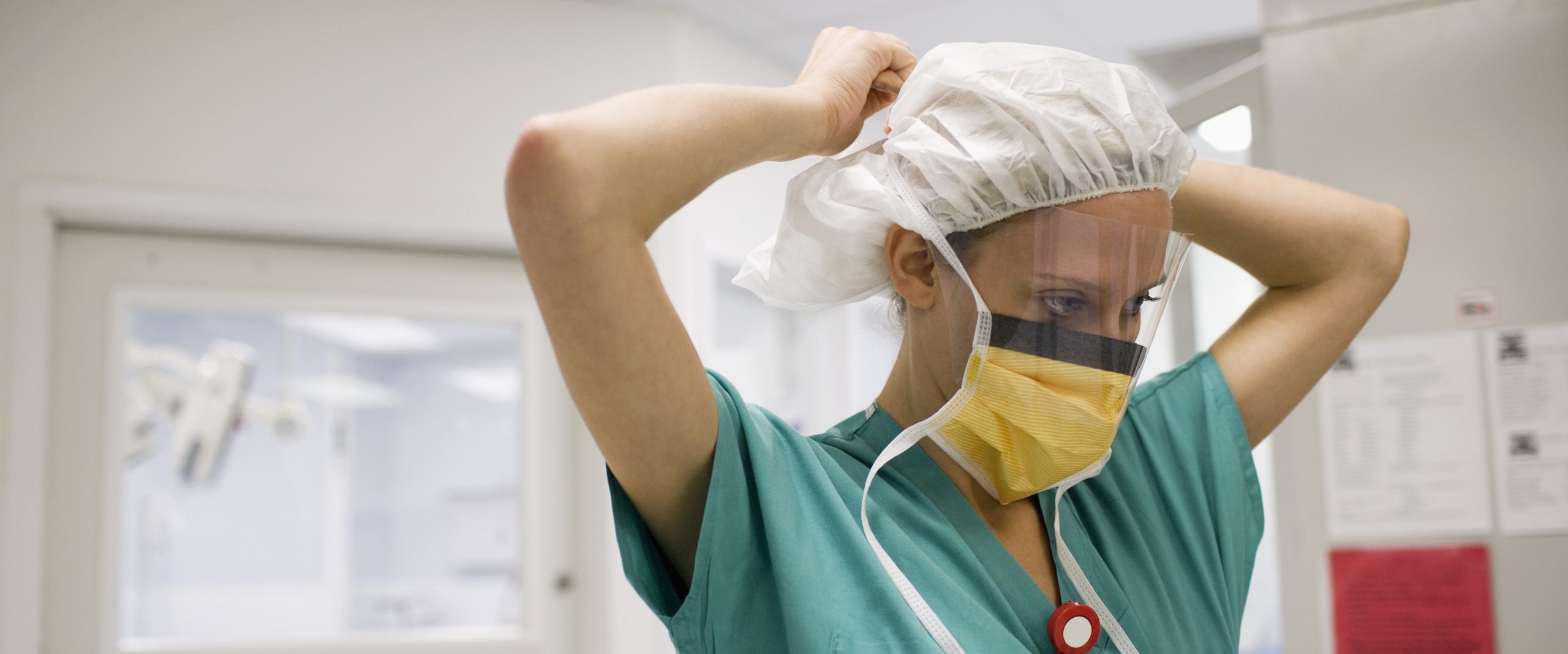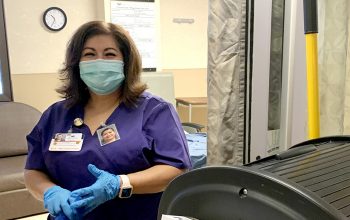Our work must always be patient-centered, says Chief Technology Officer, Paul Currie.


Paul Currie, vice president and chief technology officer for HCA Healthcare, spoke with HCA Healthcare Magazine about the work of his team during the COVID-19 pandemic. The transcript below covers how they determined priorities, met challenges and served patients and colleagues.
HCA Healthcare Magazine:
The theme for the magazine centers on pivoting, and we are hoping to illustrate how HCA Healthcare was ready to respond quickly last March when things around the world changed dramatically and rapidly. How did your team pivot to meet the needs of colleagues and patients?
Paul Currie:
I think we’ve been very fortunate that, as an organization, we’ve been able to rise to the challenges and really understand what the true needs are. That’s really helped us in trying to determine how we can pivot. So what we try to do is take a look and ask, “What are the things that really matter? What are the key things that people are asking for? What do they need? And how do we, for lack of a better term, myopically focus on those elements?” So really taking the organization and saying, “Look, if we’re going to go do telehealth, let’s focus on delivering telehealth.” We don’t need to worry about a lot of the noise. We don’t need to worry about a lot of the other aspects. We really need to focus on those things that matter in the moment.
We’re fortunate that we already had a lot of the foundational elements in play. We already had a great environment in which to operate. We already had a great network to leverage. We already had a lot of those defined; we were ready just by sheer happenstance. And obviously, strategically, we had planned on where we wanted to be, but it set us up well for what had to happen and what had to change. It obviously wasn’t perfect. We had to add other pieces, other things, to the equation, but it’s certainly served as a fantastic foundation that enabled us to move in a direction that made sense for the organization overall.
HCA Healthcare Magazine:
If we could rewind just a little, did you get a sense in March, or before March, of what could be coming? And were you already starting to put plans in place, or was there a scramble like the rest of the world?
Paul Currie:
I think there was a scramble. I don’t know that we had great insight. We obviously saw what was happening in Europe and in China previously. So there was at least a sense of the potential of something happening, but not to the degree in which it came. I think, as an organization, we were aware but did not necessarily have all our plans 100% laid out.
HCA Healthcare Magazine:
For you personally, at what point did you realize, ‘Oh, boy, things are really going to get interesting.’ And how did you prioritize? What were the needs that emerged right away, and how were you able to prioritize?
Paul Currie:
Well, I think, the first thing that started to hit was the connectivity, right? It was really enabling opportunities for no contact. Where people couldn’t necessarily be with whomever they wanted to physically, and being able to provide some of that. Now that’s an IT response. There’s another piece of that that says there’s a lot of work that has to happen in order to try to understand what the state of the organization is. And there’s a lot of data capture and data analysis, and those are some other things that were happening in other areas. But for us, it was really down to understanding how we would best react to what the requirements were and what the needs were that we were being told about by those on the front line. Ultimately that’s who takes the orders and gives the orders — that front line.
Patient Needs
HCA Healthcare Magazine: What were some of the patient needs that emerged pretty early on?
Paul Currie:
The thing that started to emerge was the ability for us to connect those patients to the outside world. The ability for family members to be able to engage and communicate with those patients. That was one of the areas that really, really came through. We had a lot of requests for different types of technologies to enable family members to connect. We were at a point where you weren’t necessarily allowed to have somebody with you in the hospital, where we were limiting visitors, where we were limiting anybody who was coming in. And so trying to get to that human bond, that human relationship was really where a lot of the requirements were early on.
HCA Healthcare Magazine:
What did you implement, and how were you able to connect patients with families?
Paul Currie:
It really came down to a series of technologies. So we use telehealth-type technologies, whether that was iPads — or it may have been other tablets, other devices that we had available, and we actually provided those on stands. There was an incredible amount of work done in the field to retrofit various types of stands, various types of equipment to enable these things to be placed in the patient rooms, in order for folks outside to be able to see and interact with the patients themselves.
HCA Healthcare Magazine:
Was there a lot of collaboration between your team and the frontline workers?
Paul Currie:
Yeah. There really was. Well, let’s put it this way. IT and the front line were ultimately one unit that worked together to deliver that. It was a key piece.
HCA Healthcare Magazine:
What were the challenges?
Paul Currie:
Well, the challenge is that you’ve got to try to keep it simple. You’ve got to try to make it easy because ultimately, it’s a nurse or it’s a physician or somebody on the care team who is trying to help the patient access this technology or have the technology work for them. It’s not like we can have an IT person in the room helping them get something figured out, set up and ready to go. It’s more trying to do that in the background before it rolls out and make sure that the technology is good.
HCA Healthcare Magazine:
What worked well?
Paul Currie:
You know, I think the fact that we were a lot more flexible than we’ve been in the past. I think the fact that we were able to do some things that maybe previously we might’ve thought weren’t necessarily aligned, governance-wise or structure-wise. We felt that we were able to do things a little bit quicker. We were able to focus on them a little bit better and take care of that. And I think that’s something that’s staying with us today. Once you focus on these things and say, “Forget the noise, forget the chatter.” Let’s just do this. It’s amazing how much you can actually accomplish. It’s amazing how much can get done when you’re narrowing down your focus, as opposed to having to worry about just about everything.
HCA Healthcare Magazine:
Was that because the need was so great so quickly?
Paul Currie:
It really was. The approach taken was that there’s only so much we can do. There’s only so much we can execute that we really need to pare that down. We had a large portfolio. We had a lot of things that we were working on prior to this, but a lot of those didn’t necessarily directly impact or have to deal with how we were reacting to COVID-19, how our patients were reacting and how our colleagues were needed. And once we started trying to focus in on those — that was where the value started to really drive.
HCA Healthcare Magazine:
What was the takeaway?
Paul Currie:
Ultimately what it comes down to is just narrowing your focus, focusing on what’s important in the moment, focusing on what you truly need. Not everything that everybody else needs, but what’s needed in order to accomplish the job at that time. That’s really what it comes down to. It’d be great if, in the next couple of years, we can continue this journey, but I think what’s going to happen is we’re going to end up going back to where we were and having far more that we’re working on. But when you’re able to take an organization and you’re able to say, “Look, instead of focusing on 20 things, we’re going to focus on five,” it’s amazing how well those five get done. And so, as we go forward, I think we’re going to be more intentional about where we assign resources and select those things that we think we can get done in a way that makes sense for the organization before going so far and so wide.
IT and the Frontline
HCA Healthcare Magazine:
When recalling this collaboration between IT and the front line, would you say that this experience made your team feel extremely close to patients and patient care, and in a more tangible way than maybe you had ever felt? That what you provided was so directly important to the patient at that time?
Paul Currie:
I’d say it brought our mission forward even more. We talk a lot about mission motivation and how we’re motivated by our mission above all else. And I’d say that we use those very principles, that guidance, in order to execute. We’ve always had that sense of wanting to help, wanting to do whatever we can. We maybe just have not been able to see that direct result. And now, to your point, we did get a chance to see that. And so, it does — it hits home a little bit harder. I’m not going to say that there’s a sense of pride, but there certainly is a sense that we did feel accomplishment.
HCA Healthcare Magazine:
And would you say your team’s work enabled patients and their families to have maybe one last interaction with each other?
Paul Currie:
It’s huge. I mean, it’s absolutely huge. We’ve all either been a part of, or seen, those stories where somebody hasn’t been able to get to a location at the right time. So here we are, as technologists being able to impact that, being able to affect people’s lives directly in a way that we, ourselves, have been touched. So it really does add another level of humanity to the technology, which is a bit of what we’re all looking for, to be honest.
Colleague Perspective
HCA Healthcare Magazine:
When it comes to HCA Healthcare colleagues throughout the enterprise, what were some of those immediate needs early on?
Paul Currie:
We think about the larger organization, the ability to remotely access our systems without actually having to be in (the office). The ability for us to quickly gain access to information that maybe wasn’t readily available. Those are the types of things that really quickly became evident. The amount of information we can make accessible. Who can gain access to what information? That’s really what started to drive [us], because you really want to understand: Where were we as a health system? What was happening? How well did we manage and track against our operating metrics?
HCA Healthcare Magazine:
What did you have to implement quickly?
Paul Currie:
We expanded capacity in quite a few systems. We basically gave ourselves some room to be able to handle the extra capacity that was needed. I do know that there are some other areas outside of our area that we worked with to help provide additional information and additional data as quickly as we could in order to make reporting possible.
HCA Healthcare Magazine:
What were some of the challenges?
Paul Currie:
In all honesty, it was the same as everything else. It just comes down to speed, time to market. How quickly can we get things done? We all knew what had to be done. It was just a matter of how quickly we could get that taken care of. Can we get the signoffs from the various groups? Is security good? Is everything else looking OK? Can we move forward? And that was really all it was.
We’re very fortunate that we have a lot of the information available, a lot of the information accessible. It’s a matter of freeing it. It’s a matter of making sure that people who need it can gain access when they need it. That’s really what that next step was.
HCA Healthcare Magazine:
Were the takeaways different?
Paul Currie:
Not really. I mean, at the end of the day, it’s all the same, right? It all comes down to how quickly can you respond, and what is it that gets in the way of your responding quickly? And it’s knocking those barriers down and really just saying, “Look, we’re just going to go get this done. Let’s just do it. Let’s grab the team, and let’s go.” I think that’s the main thrust of how this comes about.
HCA Healthcare Magazine:
What were the responsibilities of your immediate team?
Paul Currie:
My team — they’re technologists. They’re the ones who are figuring out technology. They’re not the ones implementing the technology. They’re not the ones who are doing the end work. That’s been done by the remainder of IT. We’re kind of setting the direction and showing what has to happen. A lot of what we’ve been talking about is a lot of IT’s response overall, and how the organization as a whole has done. My team was very focused on just a couple of key things. We were very focused on the network. We were very focused on making sure that there weren’t any issues from a technology perspective.
HCA Healthcare Magazine:
What kept you up at night? What did you worry about during this time?
Paul Currie:
You know, the biggest concern we probably had was, what if we had an outage? What if we had a system failure? Healthcare has switched and become a very IT function. It’s all about where you record the data, where you’re tracking, your reporting and everything. If you lose those systems, that’s it. In this area, where you can’t actually talk to somebody face to face necessarily, where you were solely relying on the technology to provide that connection, that human touch point — if that goes away, everything starts to tear; the threads really start to get pulled. And I think that was my biggest concern: that we would have an outage and that we wouldn’t have access to the systems. The nurses wouldn’t know who to talk to. Nobody would be able to communicate with anybody, and we would really be going back to paper, and nobody wanted that. Nobody wanted that at all.
As we’ve evolved as an organization, our reliance on the technology has become greater and greater, to the point that when you do have an issue, when you do have an outage, that’s certainly going to be a problem.
I think the other thing that started to take hold was capacity. I think, back then, it was more about an unknown — what capacity would be. And some of the work that some of the other groups did — standing up field hospital capabilities, putting tents out in the parking lot to try to be prepared to do everything that, ultimately, in most of our areas was not necessary — but now is probably something coming to fruition to a degree.
Telehealth
HCA Healthcare Magazine:
What did your team do to execute the rapid expansion of telehealth sites?
Paul Currie:
Telehealth really came down to “let’s just try to figure out what works.” If a patient needs to communicate with a physician, and they need to use FaceTime, we’re going to make sure that FaceTime’s available. If the physician is using ECW and it’s Healow, it’s Healow. I think the intent there was that we didn’t necessarily drive them down into a single way of having to do it. We allowed the physicians latitude in how they were delivering telehealth at the time, which really then enabled them to be somewhat comfortable in how they were doing it. We weren’t trying to shoehorn them into an approach. We really did allow it to be a lot more pervasive.
What that now means is that we’re unraveling that, because we’re starting to pull back and say, “OK, now that people are either going back to the physician, or telehealth is becoming a more standardized way of delivering some care, we are going back and standardizing that delivery.”
Paul Currie:
In the past, you might’ve gone to a physician’s office, and they’d have given you five different ways to do telehealth. Now it’s going to be one. It’s going to be “this is how we’re going to do the telehealth.” But I think dealing with what we had — where nobody was seeing patients directly, where everything was pretty much remote in any way, shape or form — giving them that ability to connect how they could was very important. Part of the challenge is consumers themselves don’t necessarily have all the equipment to connect right way. So you have to give them options. You have to give them those alternatives. I think that was a key piece.
HCA Healthcare Magazine:
Do you feel that this is something that will continue to expand and be utilized and evolve?
Paul Currie:
Yeah. I think the industry has really settled in on telehealth as being a direction of value. It’ll be interesting to see how much. I think there are different types of statistics as to how far this might go — the amount of telehealth that might be done. In some cases, it might be greater than 50% of healthcare being delivered through telehealth. In other cases, less. I think time will tell us what it really is. But I think, if anything, we’ve changed the bulk of how healthcare can be delivered. We’ve given people another way that they can get care.
And people are accepting of it. Especially the younger generation. These folks are born on the phone. They’re born digital. And I think it’s not just telehealth. I think it’s “how do you engage with people when they’re not sitting in front of you?” The old days of you get the phone call, you answer the phone. If you’re not there, they leave a message. I think now we’re getting to the point where it’s going to be texting. It’s going to be a different type of engagement paradigm for patients. They’re going to feel, hopefully, much more a part of their own care and be able to interact when they need to, how they need to. We’re going to meet them where they are rather than requiring them to come to us.
HCA Healthcare Magazine:
Do you feel like people knew that telehealth was an option before, however, the pandemic kind of forced everyone to use it? Do more people see the benefits now?
Paul Currie:
That’s exactly it. Healthcare has been dabbling with telehealth for probably a couple, three, four years. Now the interesting thing is, I’d say, telehealth has really been more of, you’ve got a specialist in another location, you’re in the clinic and they’re using telehealth to connect you to that specialist elsewhere.
I think what’s happened during the pandemic is, people were basically told, “Look, you’ve got no choice. This is how you’ve got to do it. And they’re like, “OK, I guess I’ll try it.” And then they tried it, and they were like, “Well, wait, that was it? That was incredibly easy.”
Now I think that the converse side to that though is — personally I worry about — are they getting the right information to the physician?
Are their blood pressure numbers right? Or their heart rate information — is that being carried forward correctly to the physicians? There’s a lot of technology coming out. We’ve all got watches and gadgets and gizmos. But to be honest, there’s a lot of folks out there who don’t have those. And they don’t have access to those types of devices. So how do we get that type of technology for them in order to be able to participate accurately? I think that’s going to be the next frontier. That’s the piece we’re going to start to see some innovation on.
The Motivation Behind Their Work
HCA Healthcare Magazine:
How do you see the importance of your role and your team’s role? When things really get chaotic and crazy, and it seems like people don’t appreciate what you’re doing, what do you say to yourself and your team to reinforce the importance of the work you’re doing?
Paul Currie:
We’re patient-centered. We’re doing this for the patient. I’ve been in several industries before. I’ve been in the manufacturing industry. I’ve been in retail and everything else. Back then, yes, it’s important if the line stops and you can’t manufacture anymore. There’s no doubt that’s important. But, my goodness, when you’ve got a human being in that bed and what you do, or you have the ability to do, directly affects them and affects their family — they could be your relative. They could be someone you know. They’re obviously somebody’s daughter, somebody’s son. It’s all about the patient at that point. It’s all about taking care of them. And I’m not trying to short our colleagues because, in all honesty, if we take care of our colleagues, they take care of our patients.
So ultimately our work is patient-centric. It’s about the care we deliver. And it’s about how well we’re able to do that. As I said earlier, being able to give people an opportunity to see a loved one in care when maybe they wouldn’t be able to otherwise, through telecare of some type, that’s a game changer. That’s a difference maker. You’ve now had a direct impact on lives. You’ve now had a direct impact on someone, and that’s what keeps us going. Because we’ve all been there. We all have those stories of our own. We all know those experiences.
So being able to have an opportunity to impact those and affect those is just so powerful. It really is. And that’s the drive that keeps us going. That’s what helps us get through these times — knowing that we are having a direct care impact.

Paul Currie,
Vice President and
Chief Technology Officer,
HCA Healthcare
HCA Healthcare Magazine:
Is there anything that we didn’t talk about that you feel should be covered or that you would like for colleagues and readers to know?
Paul Currie:
I think the only thing that I really want them to know is, we continue to be amazed by the front line. We continue to be absolutely dumbfounded, by how they are able to do what they do. I mean, it’s with incredible admiration that we’re so appreciative of everything. That’s really what it comes down to.


